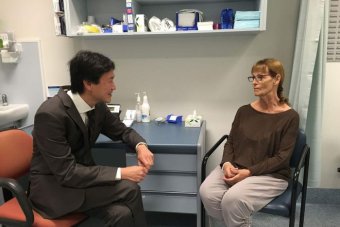Women undergoing breast cancer surgery can now have results within 30 minutes that show the extent of their cancer, enabling doctors to decide whether further surgery is needed before the patient wakes up.
The new technique is performed using an OSNA machine (one step nucleic acid amplification) and the Royal Brisbane and Women’s Hospital (RBWH) has the only one operating in Australia.
Professor Owen Ung from the RBWH said the machine provided quicker and more accurate diagnoses than previous methods used.
“If we know at the time of surgery that the lymph node has cancer cells in it then we can proceed on, and do the necessary surgery then and there, while the patient is asleep on the table, and they will wake up and have their procedure completed,” he said.
The advantage of this test is that that whole lymph gland is mashed up and goes into the machine and is tested. Therefore if there are any cancer cells at all it will be picked up.
Professor Sunil Lakhani
About 300 women undergo breast cancer surgery at the RBWH each year.
Thirty per cent of those will have cancer that has spread to the lymph nodes in the armpit and 20 per cent of those cases will require further surgery.
Professor Ung said the OSNA machine enabled surgeons to learn whether the cancer had spread and make that decision in the one operation, instead of waiting weeks for further testing and then seeing women readmitted.
“[It’s] a huge psychological benefit because they only have to be admitted once and for most people, surgery is not a small thing – it disrupts their whole life,” he said.
“Every readmission is a trauma for a patient, so if we can reduce the number of times they need to be admitted that’s a benefit.”
Test has 95 to 99 per cent accuracy rate
Professor Sunil Lakhani, state director of anatomical pathology at Pathology Queensland, said traditional testing was limited because it used only a thin section of the lymph gland, which meant undetected cancer may be present in other sections.
“The advantage of this test is that that whole lymph gland is mashed up and goes into the machine and is tested,” he said.
“Therefore if there are any cancer cells at all it will be picked up.
“At the end of that 30 minutes we’ll have a result whether it is positive or negative and bring it back to our surgeons.”
Professor Ung said the OSNA was trialled last year and showed a 95 to 99 per cent accuracy rate, compared with 50 per cent under previous methods.
He said about 50 women a year were saved from being readmitted for further surgery because of the machine.
Patient told straight away what to base decisions on
One of those patients is 71-year-old Glennis Legg from Bray Park on Brisbane’s northside.
She was first diagnosed with breast cancer six years ago.
When she came back for her final five-year check-up in November last year, doctors diagnosed her with another lump in her other breast.
“When I was diagnosed the second time I struggled with that,” she said.
“All the thoughts that went in my mind, what was wrong? I really did struggle.”
When I woke up from my surgery they told me everything, so I just knew … what to base my decisions on.
Patient Glennis Legg
Within three weeks, she was again on the operating table.
But this time, the OSNA machine was used which detected significant deposits of cancer cells in her lymph nodes, enabling surgeons to remove her lymph glands in the one operation.
After her first surgery, she had waited a month to learn if doctors had got it all.
Ms Legg said this time she knew straight away.
“When I woke up from my surgery they told me everything, so I just knew … what to base my decisions on,” she said.
Along with saving lives, Professor Ung said the machine also saved the hospital money – about $150,000 a year – through not having to readmit patients and conduct further surgeries.

